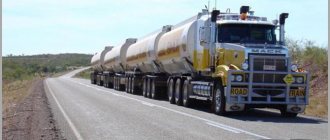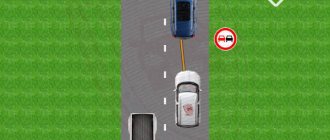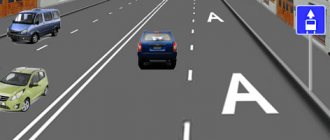New rules for conducting technical inspections in 2021 came into force on February 22. Thus, government decree No. 148 of 02/12/2018 “On amendments to the Rules for technical inspection of vehicles” .
In particular, the regulations for its conduct were changed, and the requirements for the technical condition and equipment of vehicles of various categories changed. It was decided to make amendments due to numerous complaints about the technical inspection system in force until that moment.
In addition, the new rules fully comply with the provisions of the technical regulations of the Customs Union.
Background and possible prospects
Fundamental changes to the previous technical inspection system occurred in 2012. The new regulations provided for the possibility of undergoing maintenance, including in numerous private structures that have the appropriate equipment, the necessary specialists and accreditation. Instead of maintenance tickets, diagnostic cards certified by the organization's seal began to be issued.
Almost immediately, the weaknesses of this scheme were identified. Most often, they were associated with the low quality of work of private vehicle inspection points and the low degree of control of their activities by government agencies. It is no secret that a diagnostic card was often obtained without undergoing a technical inspection of the vehicle at all, simply by paying for it according to the tariff . Therefore, various proposals began to come in to improve it.
In 2021, the Ministry of Internal Affairs proposed to introduce a number of measures aimed at strengthening control over the maintenance process. In particular, it was planned to transfer the functions of accreditation of organizations conducting technical inspections from divisions of the RSA (Russian Union of Auto Insurers) to the Federal Accreditation Service with the right to conduct unscheduled inspections of persons already involved in the work. But these proposals were never implemented.
Since the beginning of 2021, one of the divisions of the Ministry of Economic Development of the Russian Federation has been involved in the development of changes to the procedure for conducting technical inspection of transport. So, in particular:
- a bill was developed and submitted for consideration , providing for mandatory photo or video recording of the maintenance process.
- it was proposed to oblige RSA to maintain a “Unified Automated Technical Inspection System” (USTS).
- It is planned to transfer control over the activities of organizations performing technical inspection of transport to the jurisdiction of RosTransNadzor.
- It is proposed to legalize a fine of 800 rubles for driving a vehicle without passing a technical inspection.
It is proposed to place all responsibility for issuing a diagnostic card with incorrect or false data on the shoulders of the organization that issued it. In such cases, a fine of 10 thousand rubles is provided for this operator, and in case of entering obviously incorrect data into the EAISTO, it is assumed that the responsible persons may be subject to 4 years of forced labor. If these actions lead to serious bodily injury as a result of an accident or vehicle breakdown, it is proposed to increase the punishment for those responsible, up to 4 years in prison.
But so far only changes relating to the technical condition, equipment of vehicles and temporary maintenance regulations have come into force. The remaining proposals are being clarified and finalized.
Maintenance of Kia Optima 2.4 petrol 188 hp. (G4KJ)
| Types of jobs | months | 12 | 24 | 36 | 48 | 60 | 72 | 84 | 96 | 108 | 120 |
| thousand km | 15 | 30 | 45 | 60 | 75 | 90 | 105 | 120 | 135 | 150 | |
| Engine and systems | |||||||||||
| Checking/replacing drive belts/pulleys | P | P | P | P | P | P | P | P | P | P | |
| Changing the engine oil and oil filter | Z | Z | Z | Z | Z | Z | Z | Z | Z | Z | |
| Checking the engine cooling system (pipes, connections, radiator) | P | P | P | P | P | P | P | P | P | P | |
| Coolant replacement | P | P | P | P | P | P | P | Z | P | P | |
| Checking/replacing the fuel filter | P | Z | P | Z | P | ||||||
| Replacing spark plugs | Z | ||||||||||
| Checking/replacing the air filter | P | P | Z | P | P | Z | P | P | Z | P | |
| Checking valve clearances | P | ||||||||||
| Checking fuel lines | P | P | P | P | P | P | P | P | P | P | |
| Checking the crankcase ventilation system | P | P | P | P | P | P | P | P | P | P | |
| Checking the fuel tank ventilation system | P | P | P | P | P | ||||||
| Replacing the fuel tank ventilation system filter | P | Z | P | Z | P | ||||||
| Checking vacuum tubes and hoses | P | P | P | P | P | P | P | P | P | P | |
| Checking the exhaust system | P | P | P | P | P | P | P | P | P | P | |
| Diagnostics of electronic engine systems | P | P | P | P | P | P | P | P | P | P | |
| Transmission, chassis and braking system | |||||||||||
| Checking disc brakes (discs, pads) | P | P | P | P | P | P | P | P | P | P | |
| Checking brake system pipes and connections | P | P | P | P | P | P | P | P | P | P | |
| Checking/replacing brake fluid | P | Z | P | Z | P | Z | P | Z | P | Z | |
| Checking the brake pedal | P | P | P | P | P | ||||||
| Checking the parking brake | P | P | P | P | P | ||||||
| Checking steering components | P | P | P | P | P | P | P | P | P | P | |
| Checking drive shafts and wheel bearings | P | P | P | P | P | P | P | P | P | P | |
| Checking front and rear suspension components | P | P | P | P | P | P | P | P | P | P | |
| Checking/changing automatic transmission oil | P | Z | P | ||||||||
| Body | |||||||||||
| Checking the anti-corrosion coating of the body | P | P | P | P | P | P | P | P | P | P | |
| Replacing the cabin filter | Z | Z | Z | Z | Z | Z | Z | Z | Z | Z | |
| Checking the air conditioning system | P | P | P | P | P | P | P | P | P | P | |
| Wheels and tires | |||||||||||
| Checking tires (pressure and tread wear) | P | P | P | P | P | P | P | P | P | P | |
| Electrical equipment and lighting devices | |||||||||||
| Checking the battery condition (charging, electrolyte level and density, terminals) | P | P | P | P | P | P | P | P | P | P | |
| Checking external and internal lighting devices | P | P | P | P | P | P | P | P | P | P | |
| Replacing the battery of the ERA-GLONASS system | Z | Z | Z | ||||||||
Basic provisions on technical condition
The new law on technical inspection affected the following elements of vehicles:
- Headlights and headlight lenses.
- Power steering.
- Windscreen wipers.
- Gas equipment.
- Studded tires.
- First aid kit, fire extinguisher and warning triangle.
- Change of factory design.
- Leakage of working fluids.
Let's look at each of these points in more detail.
Headlights and headlight lenses
The following new requirements have been introduced for headlights and their reflective layer:
- headlights must be the same in size and shape , and their location must be symmetrical;
- the surface of the reflective marking must not have peeling or other damage.
Headlight lenses must be free of clouding, clean and free from damage that would impede the passage of light. It is prohibited to install non-structural elements on headlights, stick films on them or tint them.
This means that cars with tinted, damaged or dirty headlights, or with transparent or decorative stickers will not be able to pass inspection.
Power steering
Amplifiers of all designs (hydraulic boosters, electric boosters, etc.) installed on vehicles by the manufacturer, as well as standard steering dampers, are checked for functionality. They must not have cracks or any deformation of the working elements and body, must be fully operational and operate in accordance with the requirements set out in the technical documentation.
Separately, leakage of working fluid is not allowed in hydraulic boosters.
Windscreen wipers
From February 22, 2018, all windshield wipers and washers installed on a vehicle must be in full working order.
Previously, at least one windshield wiper was allowed to work.
Gas cylinder equipment (GBO)
Elements of the HBO system, as well as its installation and location, must comply with the requirements of clause 9.8 of Appendix No. 8 to the Technical Regulations of the Customs Union 018/2011 .
In short, the equipment must be certified, without changes in design, with a legitimate inspection period for technological indicators. The cylinder must be marked accordingly.
Installation of gas cylinder equipment should be carried out only at a specialized enterprise by certified specialists.
Studded tires
If a car uses studded winter tires, they must be installed on all wheels and have the same design (radial, diagonal, etc.), model, tread pattern, size and wear.
Installing studded tires on only one axle is now prohibited.
Tires must be used in strict accordance with traffic regulations.
First aid kit, fire extinguisher and warning triangle
Now, vehicles must be equipped, in addition to a warning triangle and a fire extinguisher, with a medical first aid kit of the established type. Its contents must not be damaged or expired.
Factory Design Change
From now on, all non-standard elements introduced into the design of the car and not included in the registration certificate will not allow it to pass inspection.
These include, in particular: power bumpers (bumpers), spacers for shock absorbers, additional headlights and lighting, non-standard antennas, etc.
Leakage of working fluids
Dripping or any leakage of oils and other working fluids from the gearbox, engine, gearboxes, steering rack, radiators, batteries, rear axle and air conditioning systems is not allowed.
Previously, leakage of working fluids was allowed up to 20 drops per minute.
In addition, several more points have been added to Appendix No. 1 to the new rules on passing maintenance (there are now 82 of them). Their content reflects additional requirements for vehicles of certain categories, for example, for emergency service vehicles, tow trucks, vehicles with tanks and cargo vans, etc. If necessary, they can be read separately.
Maintenance of Kia Optima 2.0 petrol 150 hp. (G4KD)
| Types of jobs | months | 12 | 24 | 36 | 48 | 60 | 72 | 84 | 96 | 108 | 120 |
| thousand km | 15 | 30 | 45 | 60 | 75 | 90 | 105 | 120 | 135 | 150 | |
| Engine and systems | |||||||||||
| Checking/replacing drive belts/pulleys | P | P | P | P | P | P | P | P | P | P | |
| Changing the engine oil and oil filter | Z | Z | Z | Z | Z | Z | Z | Z | Z | Z | |
| Checking the engine cooling system (pipes, connections, radiator) | P | P | P | P | P | P | P | P | P | P | |
| Coolant replacement | P | P | P | P | P | P | P | Z | P | P | |
| Checking/replacing the fuel filter | P | Z | P | Z | P | ||||||
| Replacing spark plugs | Z | ||||||||||
| Checking/replacing the air filter | P | P | Z | P | P | Z | P | P | Z | P | |
| Checking fuel lines | P | P | P | P | P | P | P | P | P | P | |
| Checking the crankcase ventilation system hoses | P | P | P | P | P | P | P | P | P | P | |
| Checking the fuel tank ventilation system | P | P | P | P | P | ||||||
| Replacing the fuel tank ventilation system filter | P | Z | P | Z | P | ||||||
| Checking vacuum tubes and hoses | P | P | P | P | P | P | P | P | P | P | |
| Checking the exhaust system | P | P | P | P | P | P | P | P | P | P | |
| Diagnostics of electronic engine systems | P | P | P | P | P | P | P | P | P | P | |
| Transmission, chassis and braking system | |||||||||||
| Checking disc brakes (discs, pads) | P | P | P | P | P | P | P | P | P | P | |
| Checking brake system pipes and connections | P | P | P | P | P | P | P | P | P | P | |
| Checking/replacing brake fluid | P | Z | P | Z | P | Z | P | Z | P | Z | |
| Checking the brake pedal | P | P | P | P | P | ||||||
| Checking the parking brake | P | P | P | P | P | ||||||
| Checking/replacing clutch fluid (for versions with manual transmission) | P | Z | P | Z | P | Z | P | Z | P | Z | |
| Checking the clutch pedal (for versions with manual transmission) | P | P | P | P | P | ||||||
| Checking steering components | P | P | P | P | P | P | P | P | P | P | |
| Checking drive shafts and wheel bearings | P | P | P | P | P | P | P | P | P | P | |
| Checking front and rear suspension components | P | P | P | P | P | P | P | P | P | P | |
| Checking/changing oil in manual transmission | P | P | P | ||||||||
| Checking/changing automatic transmission oil | P | Z | P | ||||||||
| Body | |||||||||||
| Checking the anti-corrosion coating of the body | P | P | P | P | P | P | P | P | P | P | |
| Replacing the cabin filter | Z | Z | Z | Z | Z | Z | Z | Z | Z | Z | |
| Checking the air conditioning system | P | P | P | P | P | P | P | P | P | P | |
| Wheels and tires | |||||||||||
| Checking tires (pressure and tread wear) | P | P | P | P | P | P | P | P | P | P | |
| Electrical equipment and lighting devices | |||||||||||
| Checking the battery condition (charging, electrolyte level and density, terminals) | P | P | P | P | P | P | P | P | P | P | |
| Checking external and internal lighting devices | P | P | P | P | P | P | P | P | P | P | |
| Replacing the battery of the ERA-GLONASS system | Z | Z | Z | ||||||||
Besides
The following changes have also been made to the rules of passage:
- The time regulations for technical inspections for certain categories of vehicles have changed (a corresponding table has been developed). Thus, for buses and some types of specialized vehicles it increased, but, for example, for cars of category “B” it remained unchanged.
- The diagnostic card has been modified and received new items that meet the requirements of the new maintenance rules.
Starting from February 22, 2018, all accredited persons must conduct a technical inspection of vehicles in full compliance with the changes that have entered into force.
Inspection in 2021 - changes and latest news
On February 19, Rossiyskaya Gazeta published Decree of the Government of the Russian Federation dated February 12, 2021 No. 148 “On Amendments to the Rules for Carrying out Technical Inspection of Vehicles.” In accordance with this document, the inspection procedure was adjusted, and the number of parameters checked during maintenance increased.
List of changes coming into force in February 2021:
- a motorist must have a first aid kit in his car (there has been a return to the old requirements);
- it is prohibited to operate a car without a damper and power steering, if they are provided for by the design;
- It is prohibited to tint headlights and install optical elements (does not apply to right-hand drive vehicles that require light beam correction);
- any tuning is possible only if there are documents confirming changes to the design of the car - this applies to winches, racks, homemade trunks, snorkels, etc.;
- installation of gas equipment is permitted if it complies with the regulations of the Customs Union, and there are documents on changes to the design of the car;
- When inspecting the car, there should be no leaks of oil or other technical fluids (drips);
- The tires must be of the same size, wear and type (studded or non-studded).
Windshield wiper and washer
It is stated that it will not be possible to dismantle windshield wipers or windshield washers pre-installed by the manufacturer. And if nothing is written, it means everything – the windshield, the headlights, and the rear window. If everything is more or less clear with washers, you cannot install others of a different design (for example, on a VAZ, change the one that sprays in one jet to fan nozzles).
The point about “windshield wipers” is not clear! So now I won’t be able to install other “non-original” ones on my car? Or let’s say I have “frame” ones, but I can’t install “frameless” ones? Either the issue here only concerns the fact that you cannot remove the wiper at all, as is done, say, on our VAZ 2114 or PRIOR (hatchback) where the hole is welded.
What to do if it leaks
Previously: if working fluid leaks from some systems, its quantity was measured. No more than 20 drops per minute was considered acceptable, and the technical inspection was passed. Now: drops or leaks are not allowed for any of the car systems. Even if oil stains appear or fluid leaks from the battery, this is grounds for refusal to undergo technical inspection. The same applies to the refrigerant in the air conditioner.
Therefore, it is worth repairing any leaks before you book an inspection.
First aid kit and fire extinguisher
Previously: a first aid kit was not included in the set of tools required in the car interior. The only requirement was to equip it with a warning triangle. Now: a first aid kit and a fire extinguisher have become mandatory. That is, it was previously understood that the driver must have them in the car. However, as of 2021, it has become impossible to undergo MOT and obtain a diagnostic card. A first aid kit is required even for motorcycles with a large engine capacity; specific requirements can be found in paragraphs. 56, 58 of Appendix No. 1 to the Rules.









